
by Dorothy C. Lee | Mar 3, 2020
Spring showers not only bring flowers, but beautiful fresh produce from the garden.
March in National Nutrition Month. Celebrate with nutritious delicious GREENS.
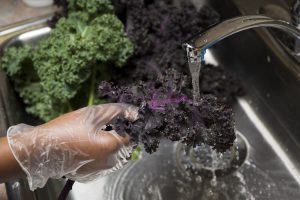
Be sure to carefully wash greens before preparing to ensure a safe and delicious product. (Photo source: Tyler Jones, UF/IFAS)
The dark leafy vegetable we refer to as “greens” range from earthy to peppery in flavor. Collard greens, mustard greens, turnip greens, and kale are often grouped together because of their texture, pronounced flavor, and general uses. They actually come from several vegetable families. In general, these tart greens are cooked before eating. The season for some varieties peak November through March.
Choose leafy greens with fresh full leaves. Avoid greens that are brown, yellow spotted, wilted, or have slimy leaves. Wash greens before use. Cut stems from leafy greens before cooking. Sauté collard greens with garlic, onions, and tomatoes a little bit of olive oil. Simmer greens in low-sodium chicken broth until greens are wilted and tender. Store greens in a plastic bag in the refrigerator for two to five days.
NUTRITION TIPS: A 1/4 cup of cooked greens is about the size of one cupped handful.
Beans and Greens
1 can white kidney beans or cannellini beans rinsed and drained
1 tablespoon olive oil
1/2 cup diced onion
2 cloves garlic, minced
2 pounds fresh kale, stemmed and chopped into large pieces
Salt and pepper to taste
Sauté onion and garlic in olive oil. Add greens to the skillet. Sprinkle with 2 tablespoon of water. Cook, tossing often, until greens are bright green and slightly wilted. Remove from heat. Drain and heat beans and add to green mixture. Toss mixture, season and serve. Serves four; 1 cup serving
Savory Greens
3 cups water
1/4 pound skinless turkey breast
1/2 cup chopped onions
2 cloves garlic, crushed
1/4 teaspoon cayenne pepper
1/4 teaspoon ground cloves
1/2 teaspoon dried thyme
1 green ground ginger
2 pounds mixed greens (collards, turnips, mustard, and kale)
Place all ingredients except greens into large pot and bring to a boil. Wash greens and remove stems. Chop greens into small pieces and add to stock. Cook 20 to 30 minutes until tender. Serves six; 1 cup serving
NUTRITION INFORMATION: Cooked greens are excellent sources of Vitamins A, C, K, and Calcium.
AVAILABLE FRESH: March – June & October – December
To learn about fresh Florida greens, please read our fact sheet: Panhandle Produce Pointers – Greens.
For more delicious produce preparation tips, please visit: http://www.panhandleproducepointers.com.

by Angela Hinkle | Jan 24, 2020
My favorite time – snack time! For February, National Snack Food Month, let’s celebrate these tasty morsels for a whole month.
Go Beyond the Snack Aisle
Snacks often have a bad reputation, at least in terms of health. It’s true that snack food aisles are often filled with high fat, high calorie, high sodium, and high sugar choices. But snacks can be great sources of fiber, vitamins, minerals, proteins, and healthier fats and carbohydrates. You may just have to wander to other parts of the store next time you shop.
Think Mini Meal
When you snack, think of it as a mini meal. Though you could plan tomorrow’s dinner to be a plate of snack cakes with a side of potato chips, hopefully you come up with something more satisfying than that – both in taste and nutrition. Additionally, when we snack on healthier foods in between meals, it gives our bodies the sustainable energy it needs to make it to that next meal.
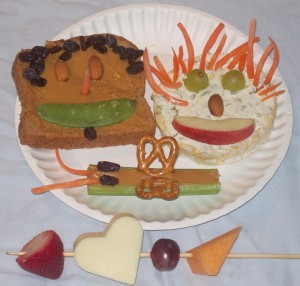
Snacks – Fun, Tasty, and Healthy
Photo Source: Angela Hinkle
Snack MyPlate
Try snacking from all five food groups this month.
- Whole grains – popcorn, granola, whole grain crackers
- Fruits – apples, bananas, oranges, raisins
- Veggies – pea pods, cucumber slices, carrots
- Dairy – string cheese, yogurt cups, individual shelf stable cartons of milk
- Protein – hard-boiled eggs, mixed nuts, healthy beef jerky
Make Homemade Mixed-Up Food Group Snacks
- Whole grain pita or multi-colored pepper slices dipped in guacamole or hummus
- Apple slices or carrots with peanut butter dip
- Cherry tomatoes with mozzarella and basil
- Fruit smoothies or protein shakes
- Yogurt with granola and mixed berries
- Banana Sushi – smear a whole wheat tortilla with peanut butter, put a banana in the middle, roll it up, then cut it into “sushi” slices
For more great snacking ideas, check out 10 Snack Tips for Parents, MyPlate Snack Tips for Kids, and 25 Healthy Snacks for Kids
Delicious, healthy, on-the-go snacks. Be creative and keep it healthy this February – National Snack Food month.
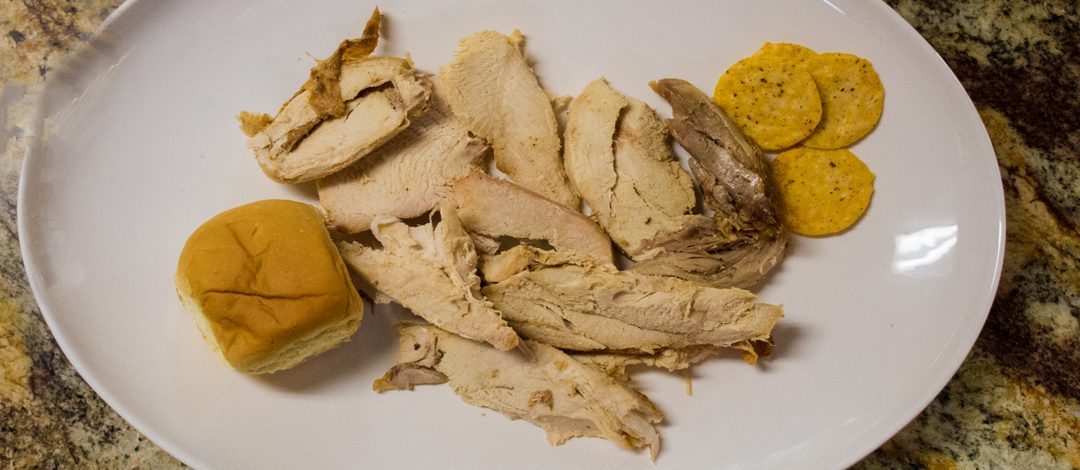
by Ginny Hinton | Nov 30, 2019

Safe and delicious holiday leftovers
Photo Source: UF/IFAS
For some of us, the best part of holiday eating is snacking on the leftovers. There’s just nothing better for a post-holiday lunch than a turkey sandwich with some cranberry dressing. With a little care and attention to detail, holiday foods can be safe and delicious for several days after the big event.
So, what do we all need to know about holiday food safety? Take a look below for some quick and easy tips.
Reheating foods in the oven: Set your oven temperature no lower than 325˚F and reheat to 165˚F for turkey or chicken. Reheat ham to 145˚F. You will need a meat thermometer to check the temperature. If you don’t already have one, they’re easy to find and fairly inexpensive. To keep your meat moist, add a little broth or water and cover it with foil or an oven-proof lid.
Reheating foods in the microwave: To keep your turkey or chicken moist, sprinkle a little broth or water and cover it. You won’t need a lot of extra moisture for microwave cooking. If your microwave doesn’t have a revolving tray, be sure to rotate the meat for even heating. Let it stand for a minute or two after heating, as it will continue to cook for a bit. Just like with oven reheating, use a meat thermometer and heat poultry to 165˚F, ham to 145˚F.
Storing your turkey: It may be a painful thought, but if any turkey, stuffing, or gravy gets left out at room temperature for more than two hours, it needs to be thrown away. It’s better to waste food than to risk getting sick, especially over the holidays! Divide leftovers into small portions so they will quickly and evenly cool. Store in the refrigerator or freeze in appropriate containers.
Important Tips: Use refrigerated turkey, stuffing and gravy within four days. If you freeze your leftovers, use them within six months for best taste and quality. Not sure how long something’s been in the refrigerator or freezer? The old maxim still holds true: When in doubt, throw it out.
Best wishes to you for a safe and happy holiday season!

by Laurie Osgood | Nov 25, 2019
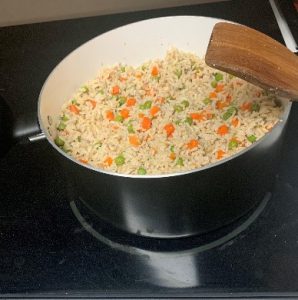
Photo credit: UF/IFAS NW District
Rice and pasta are a staple of most family meals. But did you know these simple grains can lead to a foodborne illness? Uncooked rice and pasta can contain spores of Bacillus cereus, a bacterium that can cause foodborne illness. These spores can survive even when rice or pasta is cooked. If the rice or pasta is left standing at room temperature, like in a pot on the stove, these spores can grow into bacteria. These bacteria will then multiply and produce toxins (poisons) that can cause foodborne illness. Bacillus cereus, sometimes called B. cereus, can cause nausea, vomiting, and abdominal cramps.
Preventing Contamination by B. Cereus
Because B. cereus endospores are heat resistant, they are likely to survive cooking at temperatures that would destroy other foodborne pathogens. Bacillus cereus spores can grow when exposed to heat or improper handling.
Recommendations for Proper Handling of Rice and Pasta:
- Cook rice and pasta at 135ºF or above and maintain at that temperature outside of the refrigerator.
Serve rice or pasta as soon as it is cooked.
- Cool in the refrigerator at 41ºF or below within 2 hours of cooking.
- Store rice or pasta in the fridge using a shallow container or resealable bags.
- Cooked rice or pasta can be stored in airtight containers in the fridge for 3 – 5 days.
- Do not reheat rice or pasta more than once.
During the holidays, celebrations usually center around family and good food, and, therefore, our refrigerators easily can become full. We tend to leave rice or pasta out on the stove when there isn’t any room in the fridge. This is where the problem occurs. By following proper food handling techniques, you can ensure that everyone enjoys the holidays and the fabulous foods that are part of the festivities.
To learn more about Bacillus cereus or other foodborne illnesses, contact your UF/IFAS County Extension Office.
Resources:
UF/IFAS Electronic Data Information Source (EDIS), Preventing Foodborne Illness: Bacillus cereus
The Number of Food Poisoning Cases Caused by Bacillus cereus is on the Rise. (2015, April 1). Infection Control Today. Retrieved from https://www.infectioncontroltoday.com/food-safety/number-food-poisoning-cases-caused-bacillus-cereus-rise

by Kendra Hughson | Nov 21, 2019
Cranberries were likely a part of the Thanksgiving tradition dating all the way back to the very first one. Native Americans ate dried or fresh cranberries and they used cranberries for dye and medicinal purposes. They also used cranberries to make pemmican – a mixture of berries, dried meat, and fat. Pemmican was a common nutritional dish that could be stored for months. Cranberry sauce became commercially available in its familiar canned form in 1941. These jellied cranberries can now be sold year round. Dried, sweetened cranberries, or “craisins” are also available year round and make a great addition to stuffing and salads. Fresh and frozen cranberries can be found in abundance this time of year. The festive red color and nutrients make them a great addition to many dishes. They also make a great garland for indoor or outdoor trees and other greenery.
Today, cranberries are commonly used in a variety of foods and juices. They are high in Vitamin C and a good source of fiber. Cranberries contain phytochemicals and, as part of a healthy diet, may be associated with certain health benefits like reduced risk of chronic disease. Research on the effectiveness of cranberry juice to prevent urinary tract infections is inconsistent and it should be noted that cranberry juice may interact with some medications, so consult a health care professional.
Check out this video to make a simple cranberry sauce to add to your Thanksgiving table this year.
Sources:
Cape Cod Cranberry Growers’ Association: https://www.cranberries.org/history
Bulletin #4308, Vegetables and Fruits for Health: Cranberries: https://extension.umaine.edu/publications/4308e/
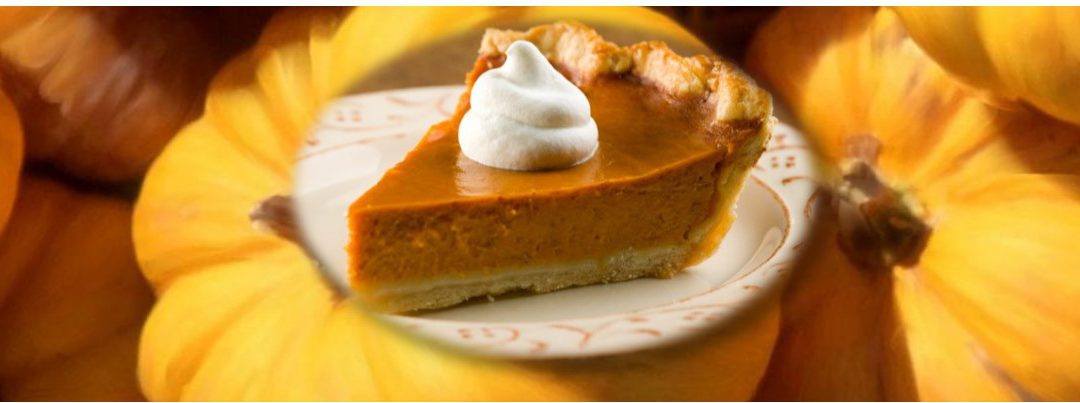
by Dorothy C. Lee | Oct 23, 2019
Pumpkins have been grown in the Americas for thousands of years. They are indigenous to the western hemisphere and were unknown in Europe before the time of Columbus. There was probably some kind of pumpkin served at the first Thanksgiving Feast.
Pumpkins, gourds, and other varieties of squash are members of the family Cucurbitaceae.
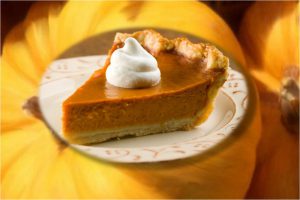
Pumpkin King of Pies
Photo Source: Esther Mudge
Baking with pumpkins during the holiday season has become a popular tradition. Pumpkin pie is king of the holiday pies.
Freshly baked pumpkin dishes are a delicious delight. It may surprise you that pumpkin is classified as a fruit, not a vegetable. Pumpkin is an excellent source of many nutrients. Pumpkin is rich in minerals like phosphorus, calcium, and iron. The pumpkin is also rich in carbohydrates. It contains vitamin A as well.
Small to medium size pumpkins are best for baking and cooking because they have a finer textured flesh than large pumpkins. Look for heavy pumpkins, and ones that do not have a hollow sound when you thump on them.
To use fresh pumpkin rather than canned pumpkin, scoop out the seeds and cut into small even pieces. The pumpkin can be peeled before or after cooking. Boil the pumpkin until tender and then mash it and use to prepare a variety of pumpkin dishes.
I like to cut the pumpkin in half, place the cut side down on a glass plate, and microwave on high for 20-25 minutes, depending on the pumpkin’s size, until tender. Then I remove the skin and beat the pumpkin in a mixer until smooth (strings will remain on the mixer blades). It’s now ready to use in any recipe.
One cup of raw pumpkin yields about ¾ to one cup of cooked, pureed pumpkin. It takes about 1 ½ to 2 cups of cooked pumpkin for a well-filled 9-inch pie.
When you carve that jack-o-lantern, don’t throw away the seeds. Roasted pumpkin seeds make a delicious, nutritious snack anytime and can be easily prepared in the microwave. See recipe below.
Pumpkin pie usually comes to mind first when the fall pie season arrives. However, pumpkin lends itself to a variety of bread, cookies, pancakes, muffins, butters, and a variety of other sweet treats. Happy Fall!!
ROASTED PUMPKIN SEEDS (in the microwave)
- 1 cup pumpkin seeds
- 1 tablespoon butter
- ¼ teaspoon seasoned salt
- Remove any fiber clinging to pumpkin seeds.
- Wash and drain well.
- Spread seeds in a single layer to dry, stirring occasionally.
- Line a 9-inch pie plate with two layers of paper towels. Sprinkle seeds on the towels.
- Microwave on HIGH 13 -14 minutes or until seeds are dry but still white, stirring every 5 minutes. Let stand 5 minutes.
- Place butter in a 2-cup measure and microwave until melted. Add seeds and salt; stir and coat.
- Serve as a snack.
FRESH PUMPKIN PIE
INGREDIENTS
FILLING:
- ¾ cup packed brown sugar
- 1 ¾ teaspoons pumpkin pie spice
- ¼ teaspoon salt
- 1 (12-ounce) can evaporated low-fat milk
- 2 eggs
- 1 ½ cup of fresh pumpkin (cooked and drained)
CRUST:
- Frozen 9-inch-deep pie crust
TOPPING:
- ¼ cup whipping cream
- 2 teaspoons powdered sugar
PREPARATION:
Place the oven rack to its lowest position. Preheat oven to 425ºF. Prepare fresh pumpkin as directed above. Be sure to drain the pumpkin after cooking. Now you are ready to use the pumpkin in recipes. To prepare filling, combine first 6 ingredients in a large bowl, stirring with a whisk. Add pumpkin and stir with a whisk until smooth. Pour pumpkin mixture into the crust. Place pie plate on a baking sheet. Place baking sheet on lowest oven rack. Bake at 425ºF for 10 minutes. Reduce oven temperature to 350ºF (do not remove pie from oven); bake an additional 50 minutes or until almost set. Cool completely on wire rack. To prepare topping, beat cream with a mixer at high speed until stiff peaks form. Add the powdered sugar and beat until blended. Serve with pie. Yield 1 Pie, about 6 -8 pieces.











